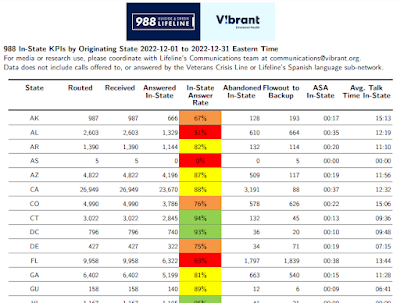Suicide hotline efficacy data: Assessment, descriptive data, t-tests, correlation, regression examples abound
ASIDE: THIS IS MY 500th POST. PLEASE CLAP.
Efficacy data about a mental health intervention? Yes, please. The example has so much potential in a psych stats classroom. Or an abnormal/clinical classroom, or research methods. Maybe even human factors, because three numbers are easy to remember than 10?
This post was inspired by an NPR story by Rhitu Chatterjee.
It is all about America's mental health emergency hotline's switch from a 10-digit phone number to the much easier-to-remember three digits (988), and the various ways that the government has measured the success of this change.
How to use this (and related material) in class:
1) Assessment.
In the NPR interview, the describe how several markers have improved: Wait times, dropped calls, etc.
Okay, so the NPR story sent me down a rabbit hole of looking for this data so we can use it in class. Here is the federal government's website about 988 and a link to their specific 988 performance data, which is a nice demonstration of simple descriptive data as well as assessment data.
 |
| https://www.samhsa.gov/find-help/988/performance-metrics |
2) This data is available.
I can imagine many tests you can run looking at the data aggregated by state, found here at 988's website. Here is a screenshot of one of their monthly reports, with the previously mentioned descriptive statistics divided up by state/territory.
 |
| https://988lifeline.org/wp-content/uploads/2023/01/FINAL-2022-12_988-State-Report-1.pdf |
Yes, you need to convert this to a .CSV. Or you can just use this copy of the Dec22 data, in which I also converted all of the times from minutes:seconds to seconds. But after you do that...
Your students can perform a paired t-test on any of the monthly reports. How? Find two months. Compare all of the states/territory performance between the two months. You can have your students replicate the exact data that Chatterjee mentions in her report.
For any given month's data, you could run a correlation and/or regression between any of the quanty variables.
And if you are fancy, you could teach repeated measure design with this data as well, using multiple months' data.
You could practice data visualization with this data as well.
3) Share a fantastic resource with your students. I know I sound dramatic, but you could introduce this resource to a student who really needs it, or loves someone who really needs it.

Comments
Post a Comment